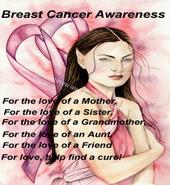FIGHT BREAST CANCERBreast cancer in malesLess than 1% of breast cancers occur in men and incidence is about 1 in 100,000. Men with gynaecomastia do not have a higher risk of developing breast cancer. The treatment of men with breast cancer is similar to that in older women. Since the male breast tissue is confined to the area directly behind the nipple, treatment for males has usually been a mastectomy with axillary surgery. This may be followed by adjuvant radiotherapy, hormone therapy (such as tamoxifen), or chemotherapy.HERE IS ONE MAN 'S STORY ON HIS BREAST CANCERBrian Crookes, Calgary, AlbertaBrian is one of the few that is one of the some 145 men diagnosed each year with breast cancer. Three years ago in Calgary, with the prodding of his wife Mary Anne, Brian persisted in seeking medical advice for a lump initially dismissed by doctors as a cyst. It was finally diagnosed correctly as a Stage II breast cancer, and signaled the start of a long process of surgery, chemotherapy and recovery. “It was the best thing that ever happened to me,†says Brian. “It completely changed my focus. Every day is a great day. There’s no time to have your head in the sand. I have a new appreciation for everything and everyone the day brings." Today, Brian is a Board member of the Prairies/NWT Chapter of the Canadian Breast Cancer Foundation and CEO of Hallmark Tubulars Ltd. He committed to being a volunteer for the Foundation because, as Brian explains, “I didn’t want to die, and I’m was terribly concerned for my two daughters being at risk for inheriting this disease. I wanted to give back for the extraordinary support, caring and attention I received from all the members of my oncology team, and do my part to give my daughters a future without breast cancer. I knew as a man talking about breast cancer, I could get attention and stand out in the crowd of survivors. I could bring renewed attention to the need for fundraising, and give a fresh angle to the importance of ongoing donor support. Alex, Brian’s sixteen year-old daughter is also an active volunteer. “Living through my father’s experience has taught me a lot about what’s important, and how to turn something negative into something positive.†A group of youth in Calgary and Edmonton initiated the Youth Advisory Council with the Prairies/NWT Chapter. It gives a voice to children whose parents have all been touched by breast cancer, and increases awareness about the disease, and how they can help raise money and support for those in their families touched by it. “You know,†Brian laughs, “guys see me surrounded by hundreds of women in pink walking in survivor parades and ask if I’m out of mind to be participating. And, I always have to say, it’s the right thing to do.â€MEN YOU CAN COPY THIS PINK AND BLUE RIBBON AND ADD IT TO YOUR SITE AS MEN GET BREAST CANCER , YOU CAN GO TO PHOTO BUCKET MAKE AN ALBUM PUT THIS THERE AND THEN TAKE THE CODE ADD IT TO YOUR PAGE . WE MUST GET THE WORD OUT NOT ONLY WOMEN ARE AFFECTED .Breast Cancer spreading elsewhere in the bodyMost people understand breast cancer as something that happens in the breast. However it can spread via lymphatics to nearby lymph nodes usually those under the arm. That is why surgery for breast cancer always involves some type of surgery for the glands under the arm- either axillary clearance, sampling or sentinel node biopsy.Breast cancer can also spread to other parts of the body via blood vessels. So it can spread to the lungs, pleura (the lining of the lungs), the liver, the brain and most commonly to the bones.Seventy percent of the time that breast cancer spreads to other locations, it spreads to bone, especially the vertebrae and the long bones of the arms, legs and ribs. Breast cancer cells "set up housekeeping" in the bones and form tumors. When breast cancer is found in bones, it has usually spread to more than one site. At this stage, it is treatable, often for many years, but it is not curable.Like normal breast cells, these tumors in the bone often thrive on female hormones, especially estrogen. Therefore, the doctor often treats the patient with medicines that lower her estrogen levels.Usually the breast cancer spreads to many bones where it eats away at the health bone, causing weak spots. The bones break easily at those weak spots. That is why you will see breast cancer patients wearing braces, using a wheel chair or complaining of aching bones. If a patient had breast cancer in the past and notices pain in her bones, she should see her doctor.Breast cancer awarenessIn the month of October, breast cancer is recognized by survivors, family and friends of survivors and/or victims of the disease. A pink ribbon is worn to recognize the struggle that sufferers face when battling the cancer.Pink for October is an initiative started by Matthew Oliphant, which asks that any sites willing to help make people aware of breast cancer, change their template or layout to include the color pink, so that when visitors view the site, they see that the majority of the site is pink. Then after reading a short amount of information about breast cancer, or being redirected to another site, they are aware of the disease itself.THIS SECTION IS SPECIAL FOR THOSE WHO LOST THEIR BATTLEDIANE CONWAYPEGGY CADMANJANIS CAMPBELLROSE NORRIS 3/21/57 TO 8/18/04SIMONE BRUNET FRAPPIER 1924 TO 1986
hoppinhare.comTHIS IS A SPECIAL SECTION FOR DOGS WHO GOT CANCER MOCHA CARTER SHE WAS A CHOCOLATE LABRADORRILEY - SAN ANDREWS MAY 31,1986 TO AUGUST 17 , 2005TUFFY HANES LUNG CANCER 1990 TO 2004MY BEST FRIEND WHO WON HER BATTLE AGAINST BREAST CANCERLAURIE SMITH AKA SPANKY THIS IS HER PAGE http://profile.myspace.com/index.cfm?fuseaction=user.viewpro file&friendid=167114224MYSPACE FRIENDROBIN WORKMAN SHE IS FIGHTING BREAST CANCER
Myspace Layouts
